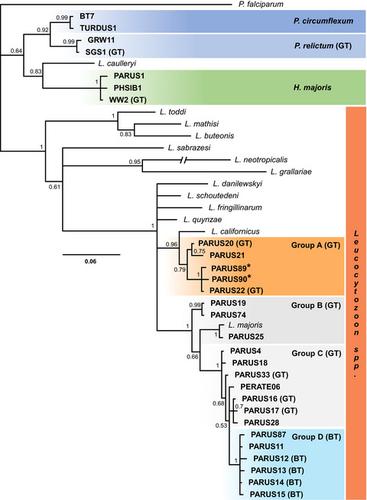当前位置:
X-MOL 学术
›
Ecol. Evol.
›
论文详情
Our official English website, www.x-mol.net, welcomes your
feedback! (Note: you will need to create a separate account there.)
Contrasting the seasonal and elevational prevalence of generalist avian haemosporidia in co-occurring host species.
Ecology and Evolution ( IF 2.3 ) Pub Date : 2020-05-27 , DOI: 10.1002/ece3.6355 Joshua G Lynton-Jenkins 1 , Aisha C Bründl 1, 2, 3 , Maxime Cauchoix 2 , Léa A Lejeune 2 , Louis Sallé 2 , Alice C Thiney 2 , Andrew F Russell 1, 2 , Alexis S Chaine 2, 4 , Camille Bonneaud 1, 2
Ecology and Evolution ( IF 2.3 ) Pub Date : 2020-05-27 , DOI: 10.1002/ece3.6355 Joshua G Lynton-Jenkins 1 , Aisha C Bründl 1, 2, 3 , Maxime Cauchoix 2 , Léa A Lejeune 2 , Louis Sallé 2 , Alice C Thiney 2 , Andrew F Russell 1, 2 , Alexis S Chaine 2, 4 , Camille Bonneaud 1, 2
Affiliation

|
Understanding the ecology and evolution of parasites is contingent on identifying the selection pressures they face across their infection landscape. Such a task is made challenging by the fact that these pressures will likely vary across time and space, as a result of seasonal and geographical differences in host susceptibility or transmission opportunities. Avian haemosporidian blood parasites are capable of infecting multiple co‐occurring hosts within their ranges, yet whether their distribution across time and space varies similarly in their different host species remains unclear. Here, we applied a new PCR method to detect avian haemosporidia (genera Haemoproteus, Leucocytozoon, and Plasmodium ) and to determine parasite prevalence in two closely related and co‐occurring host species, blue tits (Cyanistes caeruleus, N = 529) and great tits (Parus major , N = 443). Our samples were collected between autumn and spring, along an elevational gradient in the French Pyrenees and over a three‐year period. Most parasites were found to infect both host species, and while these generalist parasites displayed similar elevational patterns of prevalence in the two host species, this was not always the case for seasonal prevalence patterns. For example, Leucocytozoon group A parasites showed inverse seasonal prevalence when comparing between the two host species, being highest in winter and spring in blue tits but higher in autumn in great tits. While Plasmodium relictum prevalence was overall lower in spring relative to winter or autumn in both species, spring prevalence was also lower in blue tits than in great tits. Together, these results reveal how generalist parasites can exhibit host‐specific epidemiology, which is likely to complicate predictions of host–parasite co‐evolution.
中文翻译:

对比共存宿主物种中普通禽血孢子虫的季节性和海拔流行率。
了解寄生虫的生态和进化取决于确定它们在感染环境中面临的选择压力。由于宿主易感性或传播机会存在季节性和地理差异,这些压力可能会随着时间和空间的不同而变化,因此这项任务具有挑战性。禽类血孢子血液寄生虫能够感染其范围内的多种共存宿主,但它们在不同宿主物种中在时间和空间上的分布是否存在类似差异仍不清楚。在这里,我们应用了一种新的 PCR 方法来检测禽类血孢子虫( Haemoproteus、Leucocytozoon和Plasmodium ),并确定两种密切相关且共存的宿主物种:蓝山雀( Cyanistes caeruleus, N = 529)和大山雀中的寄生虫流行率(山雀, N = 443)。我们的样本是在秋季和春季之间沿着法国比利牛斯山脉的海拔梯度收集的,历时三年。大多数寄生虫被发现感染两种宿主物种,虽然这些通才寄生虫在两种宿主物种中表现出相似的流行升高模式,但季节性流行模式并不总是如此。例如,在两种宿主物种之间进行比较时,A 类白细胞虫寄生虫的患病率呈现反季节趋势,蓝山雀的患病率在冬季和春季最高,而大山雀的秋季患病率更高。虽然这两个物种在春季的残余疟原虫患病率总体上低于冬季或秋季,但蓝山雀的春季患病率也低于大山雀。 总之,这些结果揭示了普通寄生虫如何表现出宿主特异性的流行病学,这可能会使宿主与寄生虫共同进化的预测变得复杂。
更新日期:2020-06-26
中文翻译:

对比共存宿主物种中普通禽血孢子虫的季节性和海拔流行率。
了解寄生虫的生态和进化取决于确定它们在感染环境中面临的选择压力。由于宿主易感性或传播机会存在季节性和地理差异,这些压力可能会随着时间和空间的不同而变化,因此这项任务具有挑战性。禽类血孢子血液寄生虫能够感染其范围内的多种共存宿主,但它们在不同宿主物种中在时间和空间上的分布是否存在类似差异仍不清楚。在这里,我们应用了一种新的 PCR 方法来检测禽类血孢子虫( Haemoproteus、Leucocytozoon和Plasmodium ),并确定两种密切相关且共存的宿主物种:蓝山雀( Cyanistes caeruleus, N = 529)和大山雀中的寄生虫流行率(山雀, N = 443)。我们的样本是在秋季和春季之间沿着法国比利牛斯山脉的海拔梯度收集的,历时三年。大多数寄生虫被发现感染两种宿主物种,虽然这些通才寄生虫在两种宿主物种中表现出相似的流行升高模式,但季节性流行模式并不总是如此。例如,在两种宿主物种之间进行比较时,A 类白细胞虫寄生虫的患病率呈现反季节趋势,蓝山雀的患病率在冬季和春季最高,而大山雀的秋季患病率更高。虽然这两个物种在春季的残余疟原虫患病率总体上低于冬季或秋季,但蓝山雀的春季患病率也低于大山雀。 总之,这些结果揭示了普通寄生虫如何表现出宿主特异性的流行病学,这可能会使宿主与寄生虫共同进化的预测变得复杂。











































 京公网安备 11010802027423号
京公网安备 11010802027423号